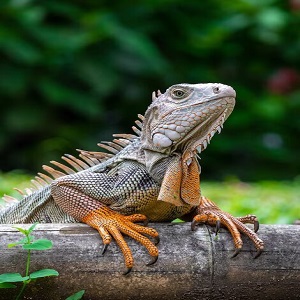Introduction to Horned Lizards:
Horned lizards , often referred to as horned toads or horny toads, are a fascinating group of reptiles known for their distinctive appearance and remarkable adaptations. Belonging to the family Phrynosomatidae, these unique creatures are found primarily in North and Central America, with a range extending from Canada to Costa Rica.
Characterized by their flattened bodies and spiky appearance, horned lizards have evolved several features that aid in their survival. One of their most recognizable traits is the presence of horn-like projections on their heads and bodies, which give them their common names. These “horns” serve both defensive and camouflage purposes, helping them blend into their arid and rocky habitats while deterring potential predators.
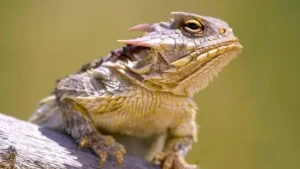
Their diet mainly consists of ants and other small insects, and their specialized physiology allows them to consume large quantities of these prey items. Interestingly, horned lizards are also capable of a unique defense mechanism: they can shoot streams of blood from their eyes as a deterrent against predators. This unusual behavior is thought to startle and repel predators, as the blood contains chemicals that are unappetizing or harmful.
Horned lizards’ interaction with ants is also noteworthy; they often rely on ants as a primary food source and can withstand ant stings due to their tough skin and specialized behaviors. These creatures play a significant role in their ecosystems by controlling insect populations and serving as prey for various predators.
Despite their remarkable adaptations, horned lizards face challenges from habitat loss, climate change, and human activities. Efforts are underway to better understand and conserve these unique reptiles, as they continue to captivate the curiosity of scientists and nature enthusiasts alike.
Physical Characteristics and Adaptations:
Horned lizards, belonging to the genus Phrynosoma, are remarkable reptiles renowned for their distinctive physical characteristics and remarkable adaptations. These small to medium-sized lizards are instantly recognizable due to their flattened, spiky appearance, with numerous pointed scales adorning their bodies. Their unique appearance serves both functional and defensive purposes in their arid habitats.
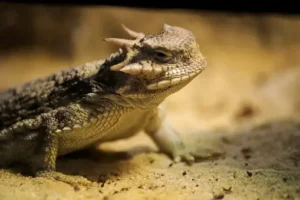
The most striking feature of horned lizards is, of course, the prominent horns situated above their eyes and on the back of their heads, lending them their common name. These horns vary in size and shape among different species and can serve as a form of camouflage, helping the lizards blend into their rocky surroundings. Additionally, their skin is covered in specialized, roughened scales that further aid in their camouflage and provide protection against predators.
Adaptations to their harsh environments are key to horned lizards’ survival. Their coloration often matches the terrain they inhabit, offering effective camouflage against predators and prey alike. Another remarkable adaptation is their ability to inflate their bodies, making them appear larger and deterring potential predators. Furthermore, their diet primarily consists of ants and other small insects, and to counterbalance the toxins present in these prey items, horned lizards possess specialized glands that produce chemicals to neutralize the toxins.
In conclusion, the physical characteristics and adaptations of horned lizards are a testament to their evolutionary success in arid ecosystems. Their unique appearance, including the distinctive horns and specialized scales, not only aids in their survival but also offers insights into the fascinating world of reptilian adaptations to challenging environments.
Habitat and Distribution:
Horned lizards, also known as horned toads or horned frogs, inhabit a range of arid and semi-arid environments across North and Central America. Their distribution spans from the southwestern United States, including states like Texas, Arizona, New Mexico, and California, to parts of Mexico and Central America.
These unique reptiles are well adapted to their harsh habitats, which typically consist of deserts, grasslands, shrublands, and sandy or rocky terrain. Their coloration and texture often allow them to blend seamlessly with the surroundings, providing effective camouflage against potential predators.
The specific choice of habitat can vary between species and even individuals. Some horned lizards prefer sandy dunes for their excellent burrowing capabilities, while others inhabit more rocky or gravelly areas. These reptiles are ectothermic, relying on external heat sources to regulate their body temperature. Consequently, they are most active during warmer periods of the day, seeking refuge from extreme temperatures by burrowing into sand or finding shade under vegetation or rocks.
However, many horned lizard populations are facing habitat loss due to urban development, agriculture, and other human activities. This loss, coupled with their relatively low reproductive rates and specialized diet, poses significant challenges to their survival. Conservation efforts are essential to ensure the preservation of these fascinating creatures and the unique ecosystems they inhabit.
Albatross: 10 Interesting Things
Diet and Feeding Habits:
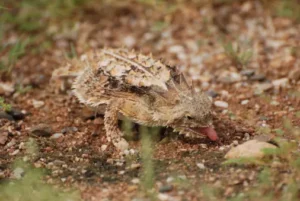
Horned lizards, a fascinating group of reptiles found in arid regions of North and Central America, exhibit unique dietary and feeding habits that enable them to thrive in their challenging environments. Their diet primarily consists of ants and other small insects, making them specialized insectivores. Their feeding habits are characterized by a few distinct features.
Horned lizards have evolved specialized jaws and teeth to crush the exoskeletons of their prey. They have a remarkable ability to consume large quantities of ants in a short period. Their menu largely consists of harvester ants, which are abundant in their habitats. These ants are rich in nutrients and provide the lizards with essential proteins.
To catch their prey, horned lizards employ a sit-and-wait feeding strategy. They blend seamlessly into their surroundings using their remarkable camouflage, waiting patiently for unsuspecting insects to come close. When prey is detected, the lizards employ rapid tongue protrusion to capture insects with impressive accuracy.
In times of food scarcity, horned lizards have been observed consuming vegetation, indicating their adaptability to varying food sources. However, their reliance on ants remains a crucial aspect of their diet.
The dietary and feeding habits of horned lizards not only highlight their specialized adaptations but also underscore their role as important predators in their ecosystems. Maintaining their habitats and preserving the balance of their prey populations is crucial for the survival of these unique reptiles.
Predators and Defense Mechanisms:
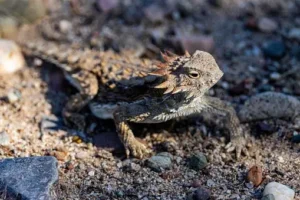
Horned lizards, also known as horned toads or horny toads, have evolved a variety of unique defense mechanisms to fend off predators in their native habitats across North and Central America. Their distinctive appearance, characterized by flattened bodies and prominent spikes or “horns,” serves as both camouflage and a deterrent to predators.
When threatened, horned lizards have an intriguing defense strategy called “bluffing.” They puff up their bodies, inflate their lungs, and open their mouths wide to appear larger and more intimidating. Some species even hiss and emit a loud, startling noise to discourage predators.
One of the most remarkable defenses of horned lizards is their ability to shoot blood from their eyes. This startling behavior is triggered by stress or fear and involves the rupture of tiny blood vessels near the eyes. The sprayed blood has a foul taste and odor, effectively deterring potential predators, such as birds and small mammals, while potentially disorienting them due to the sudden visual disturbance.
In addition to their physical defenses, horned lizards rely on their excellent camouflage to blend into their surroundings, making them difficult to spot by predators. Their coloration often matches the terrain they inhabit, allowing them to disappear among rocks, sand, and vegetation.
Despite these adaptations, horned lizards face threats from a range of predators, including birds of prey, snakes, mammals, and other carnivorous reptiles. Consequently, their unique defense mechanisms are crucial for their survival in the complex ecosystems they call home.
Reproduction and Life Cycle:
Horned lizards, fascinating reptiles known for their distinctive appearance, follow a relatively simple reproduction and life cycle. Typically, breeding occurs during the spring and early summer months. Male horned lizards engage in territorial displays and compete for the attention of receptive females. Once mating is successful, females lay a clutch of eggs in sandy or loose soil. The number of eggs varies by species but generally ranges from 2 to 15.
The incubation period for these eggs spans several weeks, during which the developing embryos are susceptible to environmental conditions. Upon hatching, miniature versions of the adult lizards emerge. They are independent from birth and must fend for themselves in terms of finding food and avoiding predators.
As they grow, horned lizards molt their skin multiple times, allowing for growth and the shedding of any parasites. Sexual maturity is typically reached after a couple of years, varying depending on species and environmental factors. The life span of horned lizards in the wild can vary, but it generally ranges from 5 to 10 years. This relatively short life span underscores the challenges they face in their often harsh and arid habitats.
Species Diversity and Classification:
Horned lizards, members of the Phrynosomatidae family, exhibit remarkable species diversity and occupy a range of habitats throughout North and Central America. Belonging to the genus Phrynosoma, these reptiles are known for their distinctive horned appearance and spiky body armor. The family Phrynosomatidae includes around 14 recognized species, each with unique adaptations and distribution patterns.
These species vary in size, coloration, and horn configurations, reflecting their adaptation to specific ecological niches. Some well-known examples include the Texas horned lizard (Phrynosoma corundum), the desert horned lizard (Phrynosoma platy rhinos), and the regal horned lizard (Phrynosoma Solare). Classification within the Phrynosomatidae family is based on morphological features, behavioral traits, and genetic analyses. Understanding this diversity and taxonomy is essential for effective conservation strategies, as different species face distinct threats and challenges in their respective habitats.
10 Astonishing Facts About Lion
Importance in Ecosystems:
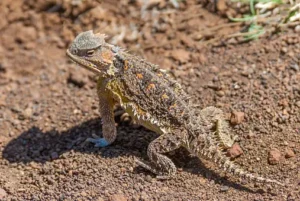
Horned lizards, though often small in size, play a significant role in their ecosystems. As insectivores, they help regulate insect populations, maintaining a balance in the food chain. Their consumption of ants, termites, and other small invertebrates prevents outbreaks that can negatively impact plant health and soil quality. Furthermore, their unique interactions with ants, like consuming them and utilizing ant nests for shelter, create a dynamic ecological link between these creatures.
Additionally, horned lizards serve as prey for a variety of predators, contributing to the energy flow within their ecosystems. Their well-documented adaptations, such as their distinctive appearance and defensive behaviors, showcase evolutionary strategies that can inspire studies in biology and natural selection. Protecting horned lizard populations is crucial not only for maintaining biodiversity, but also for preserving the intricate web of interactions that define their habitats.
Conservation Status and Threats:
Horned lizards, a diverse group of reptiles, face various conservation challenges. Many species are experiencing declining populations due to habitat loss caused by urbanization, agriculture, and land development. Additionally, these lizards are susceptible to climate change impacts, as they rely on specific temperature ranges for survival and reproduction.
Human activities also contribute to habitat fragmentation, limiting their ability to find suitable resources and mates. Furthermore, illegal collection for the pet trade and disruption of their natural habitats by off-road vehicles pose additional threats. Conservation efforts are crucial to protect these unique creatures, involving habitat preservation, captive breeding programs, and public education to raise awareness about their ecological significance and vulnerability.
Human Interactions and Folklore:
Horned lizards have captivated human interest across cultures, often becoming subjects of folklore and local legends. Indigenous communities in regions where these lizards are found have attributed spiritual and symbolic significance to them. In some cultures, the horned lizard’s unique appearance and behaviors have led to associations with protection, wisdom, and adaptability.
However, the increasing urbanization and habitat destruction threaten these creatures. Despite their intriguing features, human interactions with horned lizards can sometimes be detrimental due to collection for the pet trade or destruction of their habitats. As awareness of their importance in ecosystems grows, conservation efforts strive to balance human development with the preservation of these remarkable creatures and the cultural narratives they’ve inspired.
Research and Scientific Significance:
Research on horned lizards holds significant scientific value due to their remarkable adaptations and interactions with their environment. Their specialized physiology, including unique cranial features and antipredator strategies, captivates evolutionary biologists studying convergent evolution and predator-prey dynamics. Investigations into their blood-squirting defense mechanism offer insights into the interplay between chemical defense and predator avoidance.
Moreover, horned lizards’ sensitivity to temperature changes informs physiological studies on thermoregulation in reptiles. By unraveling these aspects, researchers gain a deeper understanding of ecological resilience and adaptation. Additionally, these lizards’ potential roles as indicators of ecosystem health and climate change effects emphasize the importance of continued research and conservation efforts.
Horned Lizards as Pets:
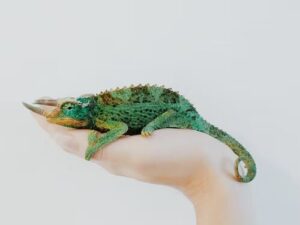
Horned lizards, with their distinctive appearance and intriguing behaviors, might seem like tempting pets. However, they are not well-suited for the average pet owner. These reptiles have specific habitat requirements, such as a sandy or rocky environment, access to natural prey (primarily ants), and regulated temperature gradients. Successfully maintaining them in captivity demands meticulous care and attention to detail.
Additionally, horned lizards have complex dietary needs and their feeding habits are closely tied to their natural environment. Their survival in captivity often hinges on a steady supply of ants and other insects. This makes them challenging to care for, particularly due to the potential difficulty in providing such a specialized diet.
Legally, it’s also important to note that capturing or keeping horned lizards may be prohibited by local laws, as many species are protected due to population declines in the wild. If one is truly interested in horned lizards, it’s advised to research thoroughly, consider the ethical implications, and potentially explore supporting conservation efforts rather than attempting to keep them as pets.
Comparative Anatomy and Evolution:
Comparative anatomy and evolution of horned lizards reveal remarkable adaptations for survival. These reptiles belong to the Phrynosomatidae family, characterized by their flattened bodies, spiky appearance, and horn-like projections. Their diverse range of habitats has driven evolutionary changes in body structure and behavior. Horned lizards’ flattened bodies aid in thermoregulation and camouflage. Their distinct horns, varying in size among species, serve both defensive and species-specific purposes.
Evolutionarily, horned lizards have developed specialized traits, such as antipredator tactics like blood-squirting from ocular sinuses to deter predators. Their diet primarily consists of ants, influencing adaptations in their jaw structure. Different species exhibit variations in coloration and markings to match local environments, indicating a co-evolutionary relationship with their surroundings.
Horned lizards’ evolutionary journey highlights the dynamic interplay between their anatomical features, behaviors, and the environments they inhabit. This adaptation-driven evolution underscores the intricate balance between survival strategies and ecological niches.
Behavioral Insights and Communication:
Horned lizards, renowned for their distinctive appearance, also exhibit intriguing behaviors and communication methods. They often bask in the sun to regulate body temperature and display territorial behavior through head-bobbing and push-up motions. Communication in horned lizards primarily involves visual cues, such as their impressive displays of horns and vivid coloration, which serve as warnings to potential predators or as a means of establishing dominance.
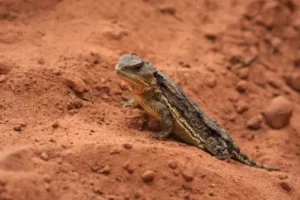
When faced with danger, these lizards might flatten their bodies and inflate, making themselves appear larger and deterring predators. Additionally, their unique ability to squirt blood from their eyes acts as both a defensive mechanism and a form of intimidation. Studying these behaviors provides insights into their evolutionary adaptations and interactions with their environment.
Unique Features: Blood-Squirting Abilities:
Horned lizards possess a remarkable defense mechanism known as blood-squirting, which is a unique adaptation designed to deter predators. When threatened, these lizards can forcefully eject blood from the corners of their eyes, aiming the stream accurately at the attacker. This surprising behavior startles predators and potential threats, providing the lizard a chance to escape.
The blood contains chemicals that are foul-smelling and taste unpleasant to predators, further deterring them. This extraordinary ability is made possible by the horned lizard’s specialized orbital sinus and blood pressure regulation. While the blood-squirting behavior doesn’t cause harm to the lizard, it serves as an effective tool against predators and exemplifies the diverse and fascinating range of defense mechanisms that have evolved in the animal kingdom.
Interaction with Ants and Other Insects:
Horned lizards have a fascinating interaction with ants and other insects that plays a vital role in their survival. These reptiles exhibit a specialized diet that primarily includes ants, which they have evolved to consume efficiently. When hunting, horned lizards use their keen sense of smell to locate ant trails. As they approach the ants, the lizards employ a unique strategy – they utilize their flattened bodies and specialized grooves to minimize the entry of ants into their mouths and nostrils.
The interaction between horned lizards and ants goes beyond just consumption. These lizards have evolved an interesting adaptation to counter the venomous stings of the ants they eat. Before consuming ants, the lizards will often provoke the ants into defensive behavior, causing the ants to release formic acid – a venomous substance – in self-defense. The horned lizards then tilt their heads upwards, allowing the acid to flow over their heads and bodies. Remarkably, they seem to tolerate the acid, and some studies suggest that it might even aid in neutralizing parasites on their skin.
This intricate interaction showcases the remarkable adaptations that have evolved in horned lizards, allowing them to exploit their insect prey while also managing potential hazards.
Mimicry and Camouflage Strategies:
Horned lizards employ intricate mimicry and camouflage strategies to evade predators and blend seamlessly into their environments. Their unique coloration and texture help them merge with their surroundings, reducing the likelihood of detection. These lizards often have a spiky appearance resembling thorns or pebbles, making them difficult to discern from their habitat’s rocky or arid terrain.
This camouflage not only conceals them from predators but also aids in ambush hunting. Additionally, certain species possess specialized color patterns that mimic the dappled sunlight and shadows, providing further concealment. Some horned lizards can alter their coloration slightly to match changing conditions, enhancing their camouflage effectiveness. These mimicry and camouflage adaptations exemplify the lizard’s remarkable ability to adapt to their environment and avoid predation.
Role in Indigenous Cultures:
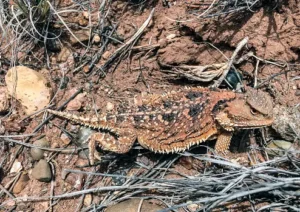
In various indigenous cultures, the horned lizard holds symbolic significance and cultural relevance. Often revered for their unique appearance and remarkable abilities, these creatures are seen as symbols of protection, resilience, and adaptability. Many tribes view the horned lizard as a source of spiritual guidance, embodying traits that reflect their own values, such as patience and the ability to thrive in challenging environments.
In some cultures, the horned lizard’s distinctive horns are associated with wisdom and foresight, leading to their depiction in myths and stories as creatures that can foresee impending changes in nature. Additionally, their ability to blend into their surroundings and employ defense mechanisms has made them emblematic of strategies for survival in the face of adversity.
The horned lizard’s role in indigenous cultures illustrates the deep connection between nature and human societies, highlighting the value of these remarkable animals beyond their scientific importance.
Physiological Responses to Extreme Temperatures:
Horned lizards exhibit remarkable physiological responses to cope with extreme temperatures in their arid habitats. These reptiles are ectothermic, relying on their surroundings to regulate body temperature. When faced with heat, they utilize behavioral adaptations like burrowing into the sand to find cooler layers or seeking shade to prevent overheating. To combat the cold, they bask in the sun to absorb heat energy and increase metabolic rates.
Additionally, they possess specialized skin that helps minimize water loss, vital for surviving in their water-scarce environments. Some species, like the desert horned lizard, can tolerate temperatures exceeding 100°F (37.8°C) due to their thermoregulatory behaviors and heat-resistant adaptations. Conversely, during cold nights, they become less active and conserve energy to endure low temperatures. These physiological responses collectively enable horned lizards to thrive across a wide range of temperatures in their demanding desert habitats.
Future Studies and Conservation Efforts:
Future studies on horned lizards are poised to delve into various aspects of their physiology, behavior, and ecological interactions. Advanced techniques in genetics could unlock insights into their evolutionary history and population dynamics. As climate change continues to impact their habitats, understanding their ability to adapt to changing conditions will be crucial.
Conservation efforts will focus on preserving their unique ecosystems, combatting habitat loss, and addressing potential threats such as invasive species. Collaborative research between scientists, local communities, and policymakers will be pivotal in developing effective conservation strategies. Public awareness campaigns and educational initiatives will also play a pivotal role in garnering support for the protection of these fascinating reptiles and their delicate ecosystems.
FAQ’s:
What is a Horned Lizard?
A Horned Lizard, also known as a horned toad or horned frog, is a reptile belonging to the genus Phrynosoma. These unique creatures are known for their distinct appearance, characterized by a flattened body, spiky scales, and prominent horns on their head.
Where are Horned Lizards found?
Horned Lizards are primarily found in North and Central America, ranging from the southwestern United States down to Central America. They are often associated with arid and semi-arid regions, such as deserts, scrublands, and grasslands.
What do Horned Lizards eat?
Horned Lizards are insectivores, meaning they primarily feed on insects. Their diet consists mainly of ants, but they may also consume other small insects, such as beetles, termites, and spiders. Their specialized diet and hunting techniques make them effective at controlling insect populations.
How do Horned Lizards defend themselves?
Horned Lizards have developed several defense mechanisms to protect themselves from predators. Their most notable feature is their ability to shoot streams of blood from their eyes, deterring attackers. Additionally, their spiky appearance and camouflage help them blend into their surroundings, making them less visible to predators.
Are Horned Lizards endangered?
Many species of Horned Lizards face threats due to habitat loss, urbanization, and changes in their environment. While not all species are considered endangered, several are listed as vulnerable or threatened. Conservation efforts are in place to protect these unique reptiles and their habitats.
